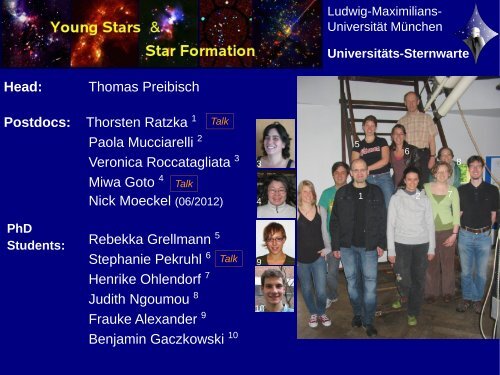You also want an ePaper? Increase the reach of your titles
YUMPU automatically turns print PDFs into web optimized ePapers that Google loves.
Head: Thomas Preibisch<br />
Postdocs: Thorsten Ratzka 1<br />
PhD<br />
Students:<br />
Paola Mucciarelli 2<br />
Veronica Roccatagliata 3<br />
Miwa Goto 4<br />
Talk<br />
Nick Moeckel (06/2012)<br />
Rebekka Grellmann 5<br />
Stephanie Pekruhl 6<br />
Henrike Ohlendorf 7<br />
Judith Ngoumou 8<br />
Frauke Alexander 9<br />
Talk<br />
Talk<br />
Benjamin Gaczkowski 10<br />
3<br />
4<br />
9<br />
10<br />
Ludwig-Maximilians-<br />
Universität München<br />
Universitäts-Sternwarte<br />
5<br />
6<br />
1 2<br />
7<br />
8
X-ray observations of<br />
star forming regions<br />
Paola Mucciarelli<br />
Frauke Alexander<br />
Chandra<br />
Spitzer<br />
Talk<br />
S255-257
Infrared Interferometry<br />
Protoplanetary Disks<br />
1 AU<br />
Thorsten Ratzka Talk<br />
Rebekka Grellmann<br />
SB<br />
(0.13<br />
AU)<br />
θ 1 D<br />
IOTA<br />
�<br />
�<br />
0.02’’<br />
Stellar Multiplicity<br />
B1<br />
0.5’’<br />
B4<br />
B2 – B3:<br />
ρ = 0.117"<br />
B2<br />
B3<br />
D1 – D2:<br />
ρ = 0.0184"<br />
HST image<br />
Bally et al. (1998)<br />
1’’<br />
θ 1 B<br />
θ 1 C<br />
SB<br />
(1 AU)<br />
0.025’’<br />
A1 – A2:<br />
ρ = 0.215"<br />
C1<br />
θ 1 E<br />
θ 1 A<br />
C2<br />
C1 – C2: ρ = 0.024"<br />
A2<br />
A1<br />
Herbig &<br />
Griffin 2006<br />
SB<br />
(0.2 AU)<br />
0.1’’
A panchromatic view<br />
of massive star feedback<br />
& triggered star formation<br />
in the Carina Nebula<br />
●Thorsten Ratzka<br />
●Veronica<br />
Roccatagliata<br />
● Stephanie Pekruhl<br />
Talk<br />
● Henrike Ohlendorf<br />
● Judith Ngoumou<br />
● Benjamin<br />
Gaczkowski<br />
Herschel far-infrared<br />
X-ray<br />
HAWK-I near-infrared<br />
LABOCA sub-mm
η Car<br />
the galaxy's most<br />
luminous star<br />
The Great Nebula in Carina<br />
Tr 16<br />
Tr 15<br />
+ 70 O + WR <strong>stars</strong> (M ✶,max ~ 120 M ⊙ )<br />
Tr 14<br />
D = 2.3 kpc<br />
15 '<br />
10 pc<br />
Orion Nebula<br />
at the same<br />
physical scale
Orion Nebula<br />
2 O <strong>stars</strong><br />
M ✶,max = 36 M ⊙<br />
Carina Nebula<br />
70 O+WR <strong>stars</strong><br />
M ✶,max ~ 120 M ⊙<br />
close enough to study low-mass <strong>stars</strong><br />
1'' = 420 AU = 0.002 pc<br />
1'' = 2300 AU = 0.01 pc<br />
30 Doradus<br />
~1000 O <strong>stars</strong><br />
M ✶,max ~ 150 M ⊙<br />
large enough to sample the top of the IMF<br />
1'' = 52 000 AU = 0.25 pc<br />
Carina is the best bridge between<br />
detailed studies of nearby regions and<br />
more massive but more distant extragalactic starburst regions
Zoom into the central region: N<br />
η Car<br />
~ 120 M ⊙<br />
log L = 6.67 L ⊙<br />
P wind = 30 000 L ⊙<br />
© <strong>ESO</strong> images<br />
Tr 16<br />
Tr 14<br />
WR 25 ≥ 70 M ⊙ , log L = 6.22 L ⊙ , P wind = 5100 L ⊙<br />
HD 93129A O3Ia, ≥ 100 M ⊙<br />
log L = 6.17 L ⊙ , P wind = 7000 L ⊙<br />
Until ~ 2010: Carina Nebula = “cluster of clusters”<br />
Feinstein 1995: estimated total population of ~ 7000 <strong>stars</strong>
Revealing the young stellar population: HAWK-I near-infrared survey<br />
600 336 infrared sources in Carina Nebula<br />
Preibisch et al. 2011, A&A 530,A43<br />
Edge-on disk<br />
Preibisch et al.<br />
2011,<br />
A&A 530, A40<br />
J-H-K s composite of the central part<br />
→ Carina Nebula contains ~ 60 000 young <strong>stars</strong>
Identifying the young stellar population:<br />
The Chandra Carina Complex Project<br />
● 14 368 X-ray point sources<br />
● 10 714 Carina members<br />
The first unbiased sample of the<br />
low-mass stellar population.<br />
≥ 80% (50%) complete at ~ 1 M ⊙ (0.5 M ⊙ )<br />
- 50% of the YSOs in clusters<br />
- 50% YSO widely distributed<br />
→ no “cluster of clusters”,<br />
but an association<br />
● Diffuse X-ray emission<br />
Stellar winds (+ supernovae ?)<br />
have filled the super-bubble<br />
with hot plasma.<br />
PI: Leisa Townsley (Penn State)<br />
CCCP Special Issue<br />
Vol. 194, May 2011
Spitzer IRAC map<br />
3.6, 4.5, 8.0 μm<br />
shows cloud surfaces<br />
+ YSOs<br />
Treasure Chest<br />
HAWK-I J, H, K<br />
Many dust columns contain<br />
young stellar objects<br />
in their heads<br />
Smith et al. 2010:<br />
Scenario of triggered star formation
Investigation of the<br />
Molecular Clouds<br />
Step 1:<br />
LABOCA 870 μm<br />
survey<br />
● Total dense cloud mass:<br />
~ 60 000 M⊙ Preibisch et al. 2011,<br />
A&A 525, A92<br />
LABOCA + optical
Investigation of the<br />
Molecular Clouds<br />
Step 2:<br />
Herschel<br />
70 – 500 μm<br />
survey<br />
● Total<br />
cloud mass:<br />
≥ 600 000 M ⊙<br />
Preibisch et al. 2012,<br />
A&A in press<br />
arXiv 1204:0627<br />
optical<br />
+<br />
Herschel 70<br />
+<br />
Herschel 350
Detailed studies of pillars Herschel temperature map<br />
Spitzer + LABOCA: 3.6 + 8 + 870 μm<br />
Recent APEX line observations:<br />
12 CO 7-6, 12 CO 6-5, 12 CO 4-3,<br />
12CO 3-2, 13CO 3-2, C18O 3-2<br />
→ gas kinematics<br />
comparison to model predictions<br />
Gritschneder et al. 2009, ApJ 694,L26<br />
→<br />
→

















